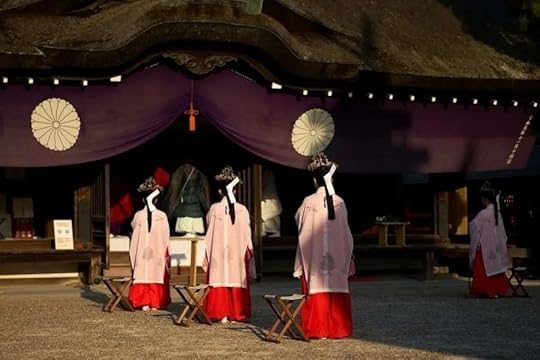Traveling with Tangled Spirits: A Book Review
What would you do if, for absolutely no fault of your own, your spirit slipped away from you and ended up in someone else’s body? And not just any body, but a 10th-century woman from Japan?
That is just what happens to Mina Cooper, a 20-year-old American college student studying in Japan.
Reeling from her American boyfriend’s infidelity and feeling a wave of doubt about her decision to major in Asian studies, she decides, uncharacteristically, to take a solo hike on Mount Tsukuba in Ibaraki Prefecture.
Not being very outdoorsy, she soon loses her path but ends up meeting a very handsome Japanese man named, Kenji, who smells slightly of cinnamon and has a voice like smooth jazz.
Kenji leads her to a “power spot” near a shrine and instructs her in meditation.
The next thing Mina knows she is wearing long red hakama trousers and a white kosode gown—just like a miko or shrine maiden. She tries to move but cannot. She calls to Kenji but makes no sound.

Instead, she hears a woman say in somewhat of a panic that she has opened a path to the spirit world and has seen a hungry ghost.
Mina realizes to her horror that SHE is the hungry ghost and that she has entered the body of Taira no Masako, a Heian-era lady of the fifth rank, in training to become a miko.
Masako tries to dislodge Mina’s spirit but cannot. Her maid, Yumi, advises her to seek an exorcism. Mina manages to break into Masako’s consciousness and begs her not to, as she is afraid doing so will strand her spirit forever in limbo.
And so begins Kate Shanahan’s delightfully inventive novel, Tangled Spirits (2022).
Mina, Masako, and Yumi travel by oxen cart from Hitachi (present-day Ibaraki) to the Heian capital (Kyoto), in an effort to seek counsel from famous court wizard, Abe no Seimei.

15th-century image of Yin-Yang Master, Abe no Seimei. Unknown artist. Wikimedia Commons.
Once in the capital, Masako (through strings pulled by her father and his relatives), is named the Imperial Medium, and is placed in the court of Empress Sadako. Heavily pregnant with her second child, Sadako is susceptible to possession by restless spirits. Masako is responsible for keeping her safe.
As luck would have it, Mina has studied Japanese history. She is able to coach Masako, who is asked to read turtle shells and divine the future.
For example, she knows that Sadako will give birth to a son and tells Masako as much. When Masako’s “prediction” comes true, the Imperial Medium earns considerable clout at court.
Knowing the future isn’t all fun and games, of course. Mina recalls that Empress Sadako’s conniving uncle, Fujiwara no Michinaga, will eventually usurp her power by having his own daughter, Akiko, named as the Junior Empress. Sadako will die in isolation.
Should Mina warn her?
This isn’t the only dilemma Mina confronts.
She and Masako don’t always see eye-to-eye. They have heated word battles with one another—all telepathically inside Masako’s mind—with no one else the wiser. Masako is naïve and trusting. Mina is eager to ingratiate herself with the wizard, Seimei, as she believes he is the only one who can send her spirit back to the 21st century.
Occasionally, Mina hijacks Masako’s body when her host is asleep. Only then can Mina make her arms and legs move of her own accord. In the process, Mina manages to engage in all kinds of faux pas. She walks too quickly, she stares at people too directly, and once, when trying to conceal her identity, she grabs a fan to shield her face only to learn that the color of fan she selected was reserved for the highest ranks.
The two women must learn to work in tandem, and not at cross-purposes, if they will achieve their goals. They also have to take care not to become too dependent on each other.
If their spirits “bind,” they will be forever entwined.
The adventures that Mina and Masako encounter are charming. They spend an evening enjoying a poetry contest, for example, they travel to the Kamo Shrine. Of greatest interest is their encounter with Sei Shōnagon, who occasionally reads from her Pillow Book.
Mina indulges in some major fangirling when she’s alone with Sei, letting her know that she will be famous and will pioneer a new literary genre. She refrains from disclosing the fate of her empress, however.
Murasaki Shikibu even makes a cameo appearance in the tale.
Despite the (likely?) fiction of a traveling spirit, the story hews closely to a historical timeline of events.
Author Kate Shanahan earned an MA degree in Asian Studies from the University of Michigan, and her novel reveals careful research. She weaves wonderful historical information into her narrative—covering birthing rituals, religious practice, poetry compositions, and more. And she does so without coming across as pedantic or boringly erudite. She stays true to Mina’s guiding spirit—describing even the most exquisite court ritual with the vocabulary of a Gen-Zer.
In fact, the novel is rich with zingers and jokes. I had a big laugh when Mina finally realizes she has ended up in the Heian era. On the one hand, she is worried that she may never return home.
On the other hand, this could be an honors thesis goldmine, to be able to learn what happened to Sei Shonagon in a way that no scholar would ever be able to do. I could get a Ph.D. out of this. ‘Youngest-ever professor of Japanese Literature’ might change my mother’s mind about my major.
 Tangled Spirits is a fun read, sending us on a fantastic adventure into an imaginary past. For me the fun is heightened by all the fabulous Heian-flavored detail: the colorful layering of silken sleeves, the poetry competitions, the momentary terror of an unleashed shikigami spirit.
Tangled Spirits is a fun read, sending us on a fantastic adventure into an imaginary past. For me the fun is heightened by all the fabulous Heian-flavored detail: the colorful layering of silken sleeves, the poetry competitions, the momentary terror of an unleashed shikigami spirit.
More than that, though, the novel delineates a young woman’s journey (both in the 10th and the 21st centuries) into self-reliance and confidence.
The post Traveling with Tangled Spirits: A Book Review appeared first on Rebecca Copeland.



